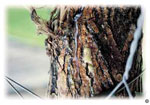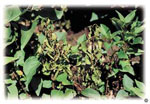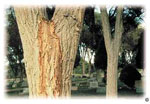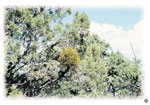Bacterial wetwood, also known as slime flux, is a common disease that affects the central core or bark of many shade and forest trees. Wetwood is common on elm, cottonwood, aspen and willow, although it may also affect ash, fir, maple, apple and poplars.

To identify wetwood, look for a yellow-brown discoloration on the trunk or branches. The area of infection is moist and under high internal gas pressure. This combination of high pressure and moisture causes slime to ooze from the tree’s central core where the problem originates. Fresh ooze is often rank, slimy and attractive to yeast fungi and insects. Dried ooze has an ashen-gray appearance.

Wetwood slime is toxic to the tree’s cambium, the tissue in woody plants that produces new cells. This means the disease will inhibit new growth where the tree is infected. Wetwood slime also is lethal to foliage, young shoots and grass.
Wetwood-infected tissue does not greatly alter the wood strength of most trees.  The low-oxygen environment created by the bacteria deters wood-rotting fungi that otherwise would weaken the tree. However, wetwood causes boards that have been cut from affected trees to warp and split when they’re dried.
The low-oxygen environment created by the bacteria deters wood-rotting fungi that otherwise would weaken the tree. However, wetwood causes boards that have been cut from affected trees to warp and split when they’re dried.
The infection process for wetwood is not well-understood. Although oozing often is associated with wounding or pruning, it’s unknown whether the tree is invaded upon injury or if the infectious microorganisms are already present.  Bacteria associated with wetwood are common in soil and water, and probably enter trees through root wounds. The oozing could transfer bacteria, causing new stem or branch wounds. Wetwood also may occur in seedlings that develop from infected seeds. Although insects feed on the slime, they cannot transmit the disease.
Bacteria associated with wetwood are common in soil and water, and probably enter trees through root wounds. The oozing could transfer bacteria, causing new stem or branch wounds. Wetwood also may occur in seedlings that develop from infected seeds. Although insects feed on the slime, they cannot transmit the disease.
Unfortunately, no effective control measures exist. The best defense is to maintain tree health and avoid mechanical damage to stem and roots. Drought conditions may increase wetwood problems. Be sure to water and fertilize infected trees especially if the tree shows nutrient deficiencies.
A tree may survive several years with wetwood. However, because bacteria prevent new growth and inhibit the transport of water and nutrients, the tree eventually will succumb to the disease.
For more information, see the following Colorado State University Extension fact sheet(s).



